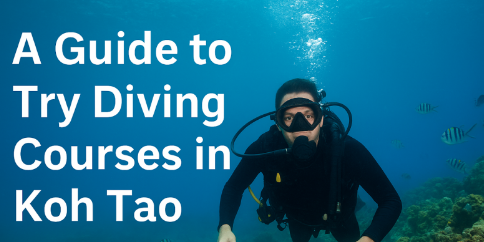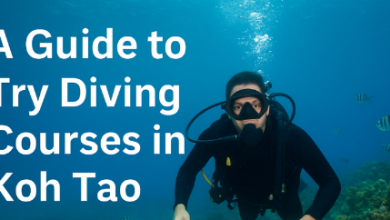A Guide to Try Diving Courses in Koh Tao

Koh Tao has become a leading destination for scuba diving courses in Asia. Every year, thousands of recreational and professional divers visit this small island to enjoy its white-sand beaches and dive into the waters to explore the beautiful marine life. The island provides the perfect environment for scuba diving courses. You can even dive without certification through the Try Diving course in Koh Tao, Thailand.
What Is a Try Diving Course?
The Try Diving course is a one-day introductory program for individuals who are not certified divers but want to experience marine life. The following are the three main components of the course:
- Theory and Briefing
The session covers essential safety rules and familiarises you with equipment and hand signals for underwater communication.
- Confined Water Practice
In this session, an instructor teaches you fundamental skills such as clearing masks and retrieving a regulator. After that, you dive into a swimming pool with a controlled environment under the supervision of an instructor.
- Open Water Dive
In the last session, you take guided dives under the supervision of a certified instructor. You can explore Koh Tao’s reefs and swim with tropical fish at a shallow, calm dive site.
So, the try diving course in Thailand’s Koh Tao offers a safe, fun, and easy way to experience scuba diving.
Why Koh Tao Is Ideal for Learning to Dive
The scuba diving capital of Thailand provides a calm, supportive environment, perfect for beginners. The warm, clear waters offer visibility ranging from 5 to 20 meters, allowing for the observation of marine life. The popular beginner diving sites such as Japanese Gardens, Mango Bay, and Twins have shallow reefs, gentle currents and an abundance of colourful corals.
Who Can Join
There are specific requirements you must meet to join the Try Diving course in Thailand, Koh Tao.
Minimum Age
You must be at least 10 years old to join this Koh Tao scuba diving course.
Parental Consent
Written parental or guardian consent is a must for anyone under the age of 18 years.
Medical Clearance
You are required to complete a medical questionnaire to confirm that you are physically and mentally fit for the course. If you have ear infections, heart problems, respiratory issues or any recent surgery, you must consult with a physician first.
Safety and Environmental Considerations
Strict Safety Standards and Training Protocols
Once it is confirmed that you are fit for diving, the instructor briefs you on:
- Hand signals for underwater communication
- Equalisation techniques to manage ear pressure
- Proper breathing
- Buoyancy control
- Emergency procedures and surface signalling
The maximum diving depth is 10 to 12 metres for beginners. The typical instructor-to-student ratios are 1:2 or 1:4. You need the following well-maintained equipment:
- Tank
- Regulator
- Buoyancy Control Device
- Weight belt
- Mask
- Snorkel
- Fins
Equipment Maintenance and Reliability
Your safety greatly depends on the quality and care of your equipment. Make sure you follow the regular maintenance protocol:
- Daily inspections
- Hydrostatic testing
- Cleaning and sanitising
- Proper air quality testing
Responsible Diving and Environmental Education
Local dive schools emphasise environmental and marine awareness as part of the course. The best practices include:
- Maintain neutral buoyancy to avoid stirring up sand or touching corals.
- Keep a respectful distance from marine animals.
- Follow the “no-touch, no-take” policy for marine life.
- Bring reusable water bottles and avoid single-use plastic to minimise waste.
Difference Between a Try Dive and a Full Certification
| Aspect | Try Diving Course | Full Certification Course |
| Duration | 1 day | 3 to 4 days |
| Level of training | Basic scuba skills:
|
Complete education:
|
| Depth | 10-12 metres | Up to 18 metres |
| Supervision | Under the direct supervision of a certified instructor | Independent diving with your buddy |
| Certification |
|
|
| Purpose | Experiencing scuba diving safely for the first time | Becoming a certified diver who can plan and conduct their own dives |
Planning Your Try Dive
This is going to be your first scuba diving experience. Make sure that you are best prepared for it.
- Make sure that the school is affiliated with SSI, PADI or RAID.
- Check the safety record and certification.
- Check the instructor-to-student ratio, ideally 1:2 or 1:4.
- Make sure your equipment is clean, well-maintained and fits perfectly.
- Join a school that provides multilingual instruction.
- Bring your swimwear, a towel, sunscreen, reusable water bottle, medical clearance and dive logbook.
- Avoid drinking alcohol at least 24 hours before diving.
- Get quality sleep.
- Eat a light meal and stay hydrated before diving.
- Postpone diving if you have a cold or sinus congestion.
- March to September is the best time for a Try Diving course.



